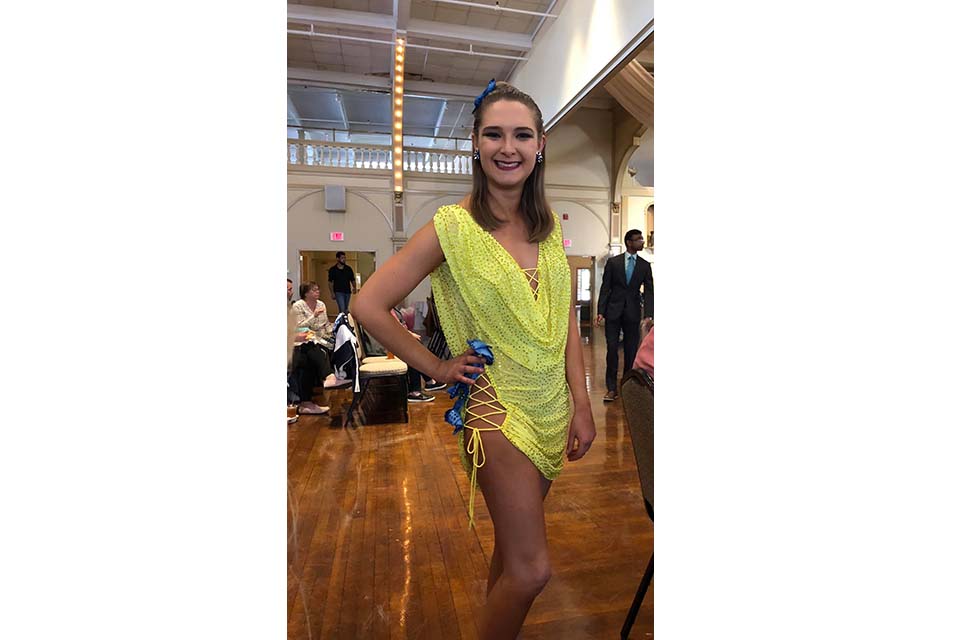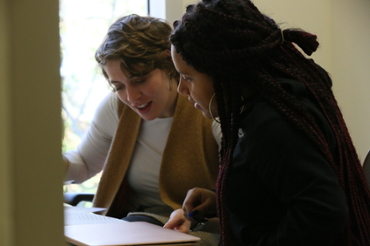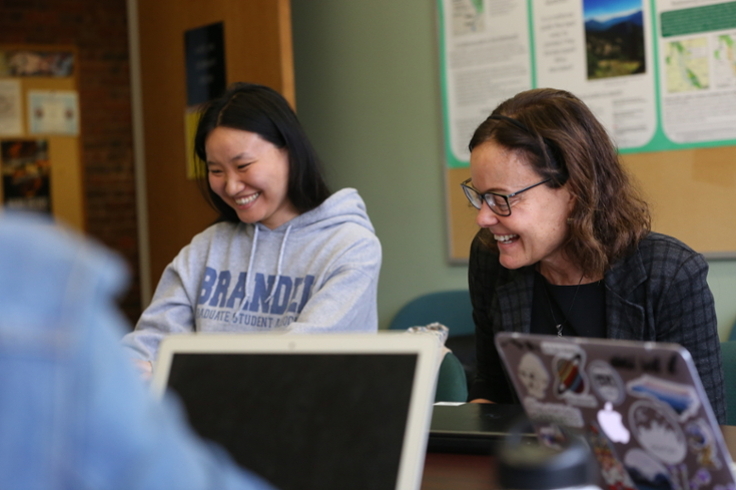Geeking Out With...Emily Calobrisi

January 3, 2025
Abigail Arnold | Graduate School of Arts and Sciences
Geeking Out With…is a feature in which we talk to GSAS students about their passions. You can check out past installments here.
Emily Calobrisi is a fourth-year PhD student in Psychology; she also earned an MA in Psychology from Brandeis in 2021. Her research looks at factors that influence public perceptions of punitive sex offender policy, an area of study that can help bring more effective laws into place. She joined Geeking Out With…to talk about her passion for ballroom dancing, which she has been doing for more than ten years.
This interview has been edited for clarity.
How did you get started with ballroom dancing?
I’ve been dancing my whole life. I did tap, jazz, and ballet as a kid. When I started college at Tufts in 2013, I started doing ballroom dancing there. I had watched Dancing With the Stars, but collegiate ballroom is very different. On Dancing With the Stars, there’s one couple on the floor at a time, but in college competitions and other professional and amateur competitions, you have multiple couples, registered for the same event, dancing on the floor at same time. If there are more than eight couples in an event, they do multiple rounds, and the best couples get called back. There are judges on the floor trying to write down your number, so you have to be as eye-catching as possible to get back to the next round. Furthermore, competitive ballroom routines are not choreographed to a particular song – you dance to whatever comes up! So your routines have to work for any song. I danced ballroom all through college and continued afterwards.
What kind of dancing do you do now, and where do you practice?
There are four competitive styles: Smooth and Standard, which include dances like the waltz, tango, and foxtrot, and then Rhythm and Latin, which include dances like the rumba and cha-cha. Smooth and Rhythm are American styles, while the other two are international styles. Right now, I am competing in Rhythm.
Brandeis has a team, but my schedule hasn’t worked to practice with them much. I know the coaches and take lessons with them separately. I practice at local studios; my dance partner is also a coach at Harvard, so I practice with her there sometimes.
You mentioned your partner is also a woman – is that common in the ballroom world?
It’s becoming more common, especially in collegiate dancing! Ballroom has tried to move on from using the terms man and woman to using the terms lead and follow. Right now I’m the follow and my partner is the lead, but in college, I would dance with another woman and we would switch off. It’s really useful to know both parts. It helps you know what your partner is doing and what they’re trying to tell you. Even though dances are choreographed, your partner might need to tell you something in the moment – for example, they might be trying to steer you out of the way of someone behind you who you can’t see! I think I’ve had four female partners and five male partners. Partnerships can work in a variety of ways, and I’m happy with where I am now.
Where do you currently compete?
We compete mostly at colleges in the New England area. This semester, we competed at Tufts and Boston University, and in the spring, we’re going to Columbia and Worcester Polytechnic Institute. COVID caused a lot of shake-ups for collegiate teams because partner dancing wasn’t allowed – my partner was coaching the University of Vermont team and they were dancing in a parking garage! – but it seems like things have now opened up and recruitment is doing well. I’ve also done additional competitions through the National Dance Council of America (NDCA), which are multi-day competitions. There’s also an organization called the World DanceSport Federation, which is working to get ballroom into the Olympics; they got breaking in for this year, although there are different camps on the topic. I do feel like ballroom is a sport, since it’s my main form of exercise and a lot of training goes into it, but I don’t know how it would be perceived by the general public. If it did get to the Olympics, it would probably just be Standard and Latin, so I wouldn’t be eligible anyway. I did all four in college, but I have since specialized because I find Smooth and Rhythm offer more creative opportunities.
I dance open level. There is a series of levels, each with its own syllabus of moves; at the open level, you can basically do what you want, as long as it’s within the character of the dance. It’s a lot more fun because it allows a lot more creativity. However, the other open competitors are the best ones there, so it can be a little intimidating, especially at bigger competitions. I didn’t start dancing open until around the time I started at Brandeis, which was in 2019 (I had worked for two years between undergraduate and Brandeis and was dancing at the same time). It takes a lot of work! After the open level, someone could move to becoming a professional, but I am not close to that. Typically, most open dancers have been out of college for years because it takes a while to get to that level; while colleges host the competitions, any adults can participate. Sometimes it does feel weird to be a thirty-year old dancing with college students, but when you have all the hair and makeup done, no one can tell anyway! And many dancers stay affiliated with college teams after graduating to have the space, community, and mentorship options.
How do you feel your relationship to ballroom has changed over the years you’ve been dancing?
When I danced as a kid, I never did any competitive dancing; we would have weekly classes leading up to a recital. With ballroom, I started to learn what being competitive was like. In the past few years, I’ve realized how important being able to dance is to me. I had knee surgery last year and was out for about a year; I only started dancing again this February. Before my surgery, the partner I had was very competitive, but my surgery forced me to think about why I wanted to dance. Now I’m less competitive and appreciate the fun, the music, and how great it is to be dancing with friends. It’s a rewarding and creative outlet, especially since my research is fairly heavy. I still want to win, but I try to be realistic.
What are some fun stories or fun facts from your time in ballroom?
Some competitions will have “fun dances,” which are not the typical styles. I dislocated my shoulder doing one once! I got turned the wrong way, popped my shoulder back in, and kept dancing. I think the judges tapped us out because they didn’t want to see me keep dancing like that. Some people don’t like to do the fun dances because they take ballroom very seriously, but I think dancing is inherently non-serious! When you’re dancing mambo, you can’t be serious: it’s all about having fun and being a little campy. Each dance has its own personality.
And a fun fact: “Mambo No. Five” is not actually a mambo! It’s a jive.
Are there people who have helped you during your time dancing?
I’ve had a lot of great coaches. Partners also help you grow in various ways, and the people you’re competing against encourage you to be better because you want to beat them.
When you’re not doing research or dancing ballroom, what else do you like to do?
At Brandeis, I’m a Graduate Department Representative. Off-campus, I like cooking, going for walks, and watching Jeopardy! (I try to watch it every day). I also love the UK show Taskmaster, which has comedians competing in different tasks.
What advice would you give to other students exploring their passions?
Keep at it, because, oftentimes, it just takes a while to get into the swing of things. Comparing yourself to people who have been doing something for a while isn’t fair – you have to set your own goals. It’s good to set small goals and try to appreciate how far you’ve come. I think that’s fair for both ballroom and doing research! Everyone’s research is so different, so it’s not useful to compare; instead, think about what you’ve accomplished and get support from your peers. You’re not alone!






